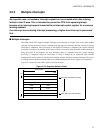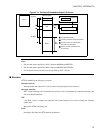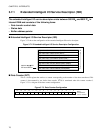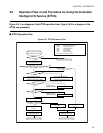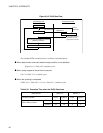
74
CHAPTER 3 INTERRUPTS
3.7 Extended Intelligent I/O Service (EI
2
OS)
The EI
2
OS function, a kind of hardware interrupt operation, automatically transfers data
between input and output and memory. An interrupt processing program was
conventionally used for such processing, but EI
2
OS enables data transfer to be
performed like DMA (direct memory access).
■ Extended Intelligent I/O Service (EI
2
OS)
EI
2
OS has the following advantages over the conventional method:
• The program size can be small because it is not necessary to write a transfer program.
• No internal register is used for transfer, eliminating the need for register saving and increasing the
transfer speed.
• Transfer can be terminated from I/O, preventing unnecessary data from being transferred.
• The buffer address may either be incremented or left unupdated.
• The I/O register address may either be incremented or left unupdated (buffer address is update).
At the end of EI
2
OS, processing automatically branches to an interrupt processing routine after the end
condition is set. Thus, the user can identify the end condition.
To implement EI
2
OS, the hardware is distributed in two blocks. Each block has the following registers and
descriptors.
• Interrupt control register: Exists in the interrupt controller and indicates the ISD address.
• Extended intelligent I/O service descriptor (ISD): Exists in RAM and holds the transfer mode, I/O
address, number of transfers, and buffer address.
Figure 3.7-1 outlines the extended intelligent I/O service.








